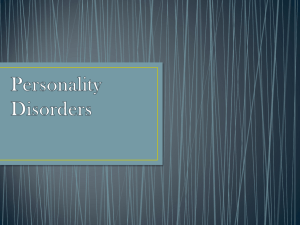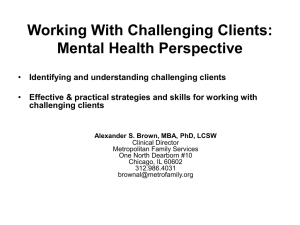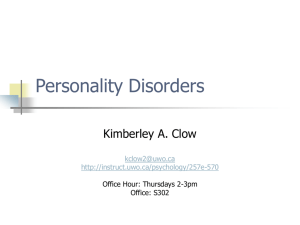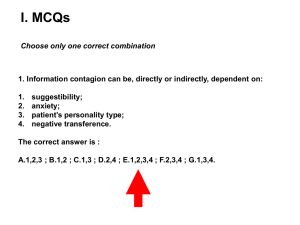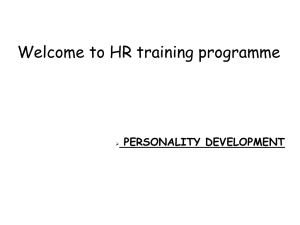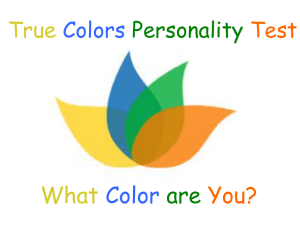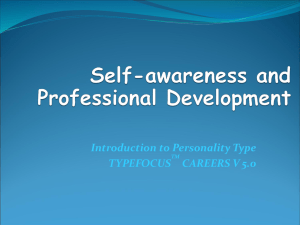Assessment and Treatment of Personality Disorders (PD)
advertisement
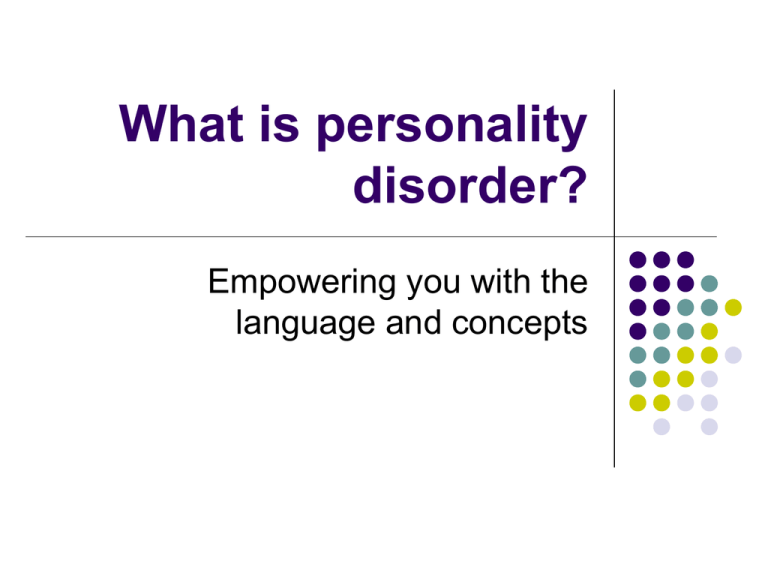
What is personality disorder? Empowering you with the language and concepts Personality We all have one. It makes us unique. It shapes how we understand and interact with the world 3 P’s Pattern of relating to self, other and the world that deviates from cultural norm. 50-78% prisoners believed to meet criteria for one or more PD. 10% of people in the community would meet criteria for PD. A helpful way of thinking about PD relates to the 3 P’s Persistent Pervasive – happens frequently – across different circumstances Problematic – and cause problems for themselves and others Immune system metaphor Millon (2004) Personality = Psychological equivalent of body’s immune system Robust immune system responds constructively & appropriately to our environment. PD = system that interacts with the environment Rigidity in strategies + Others reactions = Repeated bad one-act play PD Diagnosis Labelling and the Disease model Classification into PD types Categories based on “pure” prototype. Assumes each personality disorder is distinct Akin to diagnosing a disease that you either have or don’t have Diagnostic systems DSM IV-TR ICD-10 Paranoid Schizoid Schizotypal Antisocial Borderline Histrionic Narcissistic Avoidant Dependent Obsessive Compulsive Not Otherwise Specified Paranoid Schizoid Dissocial Emotionally unstable Histrionic Anankastic Anxious Dependent Other specific PD Unspecified PD Mixed and other PD DSM Clusters Cluster A Odd / Ecentric Cluster B Dramatic / Erratic Cluster C Anxious / Fearful Character Assassination Schizoid Schizotypal Borderline Antisocial/ Psychopathy Histrionic Pros and Cons of Types Facilitates communication by the use familiar language between professionals. It’s best we’ve got at the moment. Enables quick signposting to services Rarely find “pure types” in real life. People are individuals. BPD = 5 of 9 criteria = potentially only 1 symptom overlap. Lack of empathic understanding of the origins and maintenance of the problem which is central to therapy. Stigma facilitates reactions in others which perpetuates the problem (eg. verbal attack driven by paranoid interpretation is met by defensiveness, which further creates suspicion in the individual). Dimensions of personality The direction to be taken in DSM-V? Dimensional perspective 1) 2) Personality represented by severity of traits rather than distinct categories. Or, ASPD variations = Normal variation: Pathological variation Adventurer, Independent, Courageous Callous, Lacking conscience Breaks rules Impulsive ‘Normal’ continua of Antisocial Normal variation Adventurer, lives life on the edge, pioneers, risk-takers, courageous and tough. Slight pathological normal variation Does things own way, flirts with legal boundaries, dislikes daily routine, action-oriented, independent thinkers, confrontational and masterful leaders. Cusp No forensic history but only due to being good at covering their tracks, will deceive and exploit by minimising negatives and exaggerating positives but not physically cruel, industrialists, exploit legal technicalities and loopholes for personal gain, “smooth-talking businessman”, “dodgy used-car salesman”. ‘Normal’ continua of Paranoid Normal variation Highly independent, value their freedom, sensitive to issues of power, authority and domination. Cautious and reserved with others and enter relationships only after careful consideration. Touchy, but not intimidated, when given criticism Paranoid “style” Distant from others, places premium on honesty and loyalty. Plays cards closely to chest with acquaintances. Attuned to subtleties and nuances of communication at many levels. Skeptical. Dimensions of personality Five Factor Model (Costa & McCrae, 1992) - five dimension (primary traits): Openness to experience vs tradition/convention a general appreciation for art, emotion, adventure, unusual ideas, imagination, curiosity, and variety of experience Conscientiousness vs negligence tendency to show self-discipline, act dutifully, and aim for achievement. Preference for planned rather than spontaneous behaviour Extraversion vs introversion characterized by positive emotions engagement with the external world enthusiastic, action-oriented individuals Agreeableness vs antagonistic tendency to be compassionate and cooperative rather than suspicious and antagonistic towards others Neuroticism vs emotional stability emotionally reactive and vulnerable to stress DAPP (Livesley & Jackson 2009) Cluster label Contributing dimensions Emotional dysregulation Affective lability Cognitive dysregulation Insecure attachment Submissiveness Anxiousness Identity problems Oppositionality Dissocial Behaviour Conduct problems Narcissism Stimulus seeking Callousness Rejection Social Avoidance Compulsiveness Intimacy problems Restrictive expression Compulsivity Low affiliation Pros and Cons of Dimensions Research gives greater support to the dimensional view of personality Engenders a more compassionate understanding of personality Diagnostic types can be translated into dimensions No consensus about nature and number of dimensions More complex picture of personality = more difficult to comprehend and communicate to other clinicians
